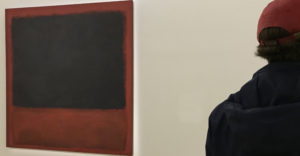One of the arguments in favor of analog audio, LPs, and vacuum tubes, is that an analog signal is closer to the real continuous acoustic waveform; that analog is a perfectly smooth wave, just like sound in air. Digital, in contrast, is broken up bits. The beautiful, smooth, continuous sound wave has been chopped to pieces and stacked together in jagged blocks. How could that possibly sound natural, or even good? Both of these beliefs rely on certain assumptions.
Assumption number one : Sound waves are smooth and continuous. Well. . , kinda, sorta, maybe. Air, the medium sound travels through, is not smooth and continuous. It’s a myriad of atoms and molecules floating around in space, bumping into each other—hardly smooth or continuous. Converting the sound wave into an electrical wave makes for an excellent analogy. The electrical wave is likewise individual electrons all jostling around interacting with each other in the medium of copper or silicon. It’s not exactly perfectly smooth and continuous either.
Analog reel-to-reel tape is made up of grains of magnetic molecules, rather large ones at that. If you know the basics of tape recording, you’ll know that wider tape, running at a faster speed makes for a higher quality recording. Cassette tapes, 1/8″ wide running at a snail’s pace of 1 7/8 inches per second, can’t hold a candle to a studio deck with 1″ tape running a 15 or 30 inches per second. The simple explanation is resolution, that is, the number of molecules holding the signal is 64 times greater on the 1″ tape. (Given both are four track—1″ is 8 times wider, and 15ips is 8 times faster, 8×8=64.) This allows for a stronger signal, wider dynamic range, wider frequency response, and less distortion in every way distortion can be measured—wow & flutter, harmonic, noise (tape hiss), etc., and yet it’s still not perfectly smooth.
Vinyl is subject to much of the same, plus more issues to deal with—groove depth and width, cutter and stylus size and shape, chemical makeup of the vinyl, friction, and variables associated with the shrinking radius from outside to inside grove. Add to this the mechanical elements—turntable, tonearm, cartridge—and you’ve got a chain of discontinuity, changes in medium and method of carrying the wave. Every change, every point of contact, entails a loss of information, loss of accuracy, loss of fidelity.
But the real deception comes from how we’ve constructed our conceptual models of analog and digital. The model of a continuous waveform is a way for us to describe and understand what’s happening in the air acoustically, or in a wire electrically. Discreet bits, 1 or 0, on or off, is how we understand digital. Neither is an exact picture. Both are only models of reality.
 Assumption number two : Digital bits appear to be disconnected chunks—jagged pieces of the wave that are missing huge portions of information in between the sampled bits. It may seem that a mere forty-four-thousand-one-hundred bits per second is inadequate to represent an apparently infinitely smooth waveform, however forty-four-thousand samples per second is all that’s needed to encode a waveform up to 22kHz, frequencies beyond human hearing. It doesn’t have to be a perfectly smooth representation, because all the audible information is there. But the biggest deception of digital is that the playback is in bits. No, no one listens to digital bits. We listen to the analog reconstruction of the digitally encoded original analog waveform. Digital is simply a different way of representing (recording and storing) a sound wave. And because the sound is being encoded without mechanics imparting its grunge, or grains of magnetic oxides adding their own noise, or diamond styluses grinding across vinyl, digital is able to save the wave as clean and pure as the original signal fed to the analog-digital converter. And that digital code can be manipulated, controlled, copied, and recopied without adding noise or distortion as happens invariably at every step with analog processing. Digital is an audio (and video) miracle.
Assumption number two : Digital bits appear to be disconnected chunks—jagged pieces of the wave that are missing huge portions of information in between the sampled bits. It may seem that a mere forty-four-thousand-one-hundred bits per second is inadequate to represent an apparently infinitely smooth waveform, however forty-four-thousand samples per second is all that’s needed to encode a waveform up to 22kHz, frequencies beyond human hearing. It doesn’t have to be a perfectly smooth representation, because all the audible information is there. But the biggest deception of digital is that the playback is in bits. No, no one listens to digital bits. We listen to the analog reconstruction of the digitally encoded original analog waveform. Digital is simply a different way of representing (recording and storing) a sound wave. And because the sound is being encoded without mechanics imparting its grunge, or grains of magnetic oxides adding their own noise, or diamond styluses grinding across vinyl, digital is able to save the wave as clean and pure as the original signal fed to the analog-digital converter. And that digital code can be manipulated, controlled, copied, and recopied without adding noise or distortion as happens invariably at every step with analog processing. Digital is an audio (and video) miracle.
So, why are so many a’philes in love with LPs and tubes? Why do they categorically state that analog “blows digital out of the water, man“? In a single word : involvement.
A couple of taps on a touch screen to cue up a digital file doesn’t compare to the ceremony of LP playback—pulling the 12″ album from the shelf, extracting the sleeved LP, carefully removing it from its inner liner, touching only on the outer edge and the label, placing it tenderly on the turntable’s platter, cleaning the surface, and gently, gently setting the tonearm on the spinning spiral. Oh, and the big album cover with artwork and text you can read by moonlight. It’s a sonata of involvement. One is invested even before a sound is heard. And don’t underestimate the investment, not only in ritual and time, but in the monetary resources required—good analog costs more, much, much more. Then. . , there’s the sound.
There is something special about the sound of vinyl. It is not sterile. It’s full and rich. Full of resonances and rumble; rich in harmonics, surface noises, and crosstalk. It takes extra concentration to listen through the encompassing steamy warmth of LP colorations. Those extras hide details that our mind’s ear needs to fill in. The extra engagement, extra effort, makes LP listening more demanding, more involving. And when we fill in the missing pieces with our imagination, aaahhh, there’s a rainbow world of blooming, blushing beauty to behold. This brings us to valves. Vacuum tubes add an additional layer of harmonic and resonant color to the sound—plus more time, and effort, and cost. It’s no wonder why some people are so enamored with these quaint, antiquated technologies, and swear by them. Consequently, analog lovers are unable to get their ears around the clean, unembellished sound of digital. Digital requires no extra effort, no engagement, no imagination. It presents us with the complete, clear, crystalline details flat out—direct and raw—straight, no chaser.
With all that added color, there’s no way that analog, in any form, can deliver a more perfect waveform of the original music than digital can no matter how we model it, no matter how we hear it. It matters little that analog appears to be more akin to acoustic waves when sounds waves are in themselves granular. Waves don’t, in reality, exist as infinitely continuous. And it doesn’t matter that digital is made of discreet bits because we don’t listen to bits. After all the processing a recording goes through, whether analog or digital, the final result, what we hear, is only the sound reproduced by the speakers.
 Ultimately, one could argue, digital is, in reality—quantum reality—closer to reality. At some point everything reduces to a quantum unit—energy, matter, gravity, space, and time.
Ultimately, one could argue, digital is, in reality—quantum reality—closer to reality. At some point everything reduces to a quantum unit—energy, matter, gravity, space, and time.
![[art]by[odo]](https://artbyodo.net/wordpress/wp-content/uploads/2011/03/cropped-Header.jpg)



